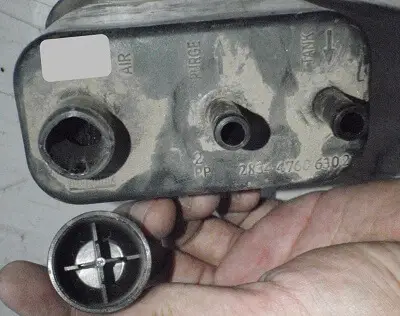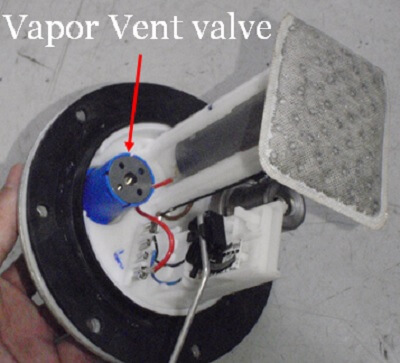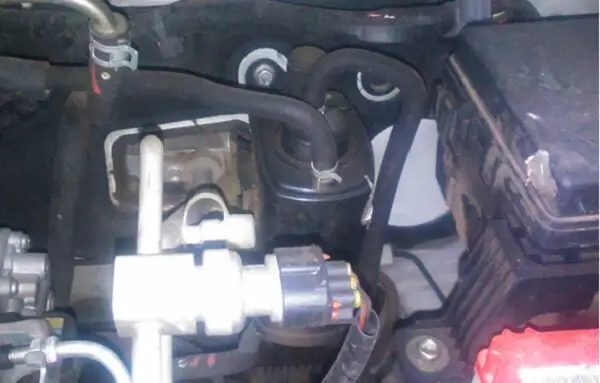We all know that gasoline fuel is a highly volatile compound. It immediately evaporates when exposed to open an atmosphere due to its inherent properties.
Whenever we fill gas inside the fuel tank the fuel vapor which is already present has to be displaced by liquid fuel so that there will not be any backpressure while gas filling.
When you happen to open the bonnet of your vehicle, sometimes you may notice the charcoal canister is full of gas due to some abnormalities.
Table Of Contents
The issue of a charcoal canister filled with gas could be due to overfilling of a gasoline tank, saturated vapor canister, clogged off charcoal canister ports, improper carburetor float, or a faulty tank vent valve.
The fuel system is vented to the atmosphere via. the charcoal canister but if there is a problem with it, then you would face a lot of vehicle-related problems.
If you are facing similar problems, and looking for a fix, then you are in right place.
Here in this article, we will get to know the root cause of the issue of gas coming out of the charcoal canister and the ways to fix it.
What Is EVAP System?
Before we proceed further, it is a prerequisite to know how the EVAP system works to better understand the charcoal canister function.
Fuel vapors are typically generated due to environmental temperature changes throughout the day.
If these vapors are left uncontrolled then they will find their way to the outside atmosphere.
With the help of the EVAP system, instead of releasing these tank’s gas vapors into the atmosphere, the air vapor mixture is released into the charcoal canister.
Hence vehicle manufacturers use an evaporative emission control system (EVAP) to collect and control the gasoline vapors that are generated inside the fuel tank by using the below system parts.
EVAP system consists of various parts which are fitted in some sequence starting from fuel tank with a pressure sensor, pressure switching/bypass solenoid valve, charcoal canister, vent solenoid valve, and purge control valve.
Gasoline vapors that are developed inside the fuel tank are passed onto the charcoal canister where it gets stored.
The charcoal canister holds the vapors until the purge control valve opens leading to the purging of vapors from the canister to the engine intake manifold due to engine vacuum.
The purge valve opens when it receives a voltage signal from Electronic Control Unit (ECU) under favorable engine operating conditions and applies the engine air intake manifold’s suction vacuum to the canister to pull the vapors from it.
What Is Inside A Charcoal Canister?

A charcoal canister is one of the main parts of EVAP. This consists of an outer plastic body filled with charcoal pellets.
These are not simple pellets, they are activated particles that undergo several process to form many minute pores within a single pellet which increases the surface area of the pellet.
Like this, the canister has got several such pellets forming millions of pores and an enormous surface area for the adsorption of gasoline vapors over it.
Charcoal has one port marked ‘TANK’ to collect the vapors coming from the fuel tank and one outlet port marked ‘PURGE’ to discharge the vapors adsorbed to the engine air intake manifold via. purge control valve.
The port named ‘AIR’ is to allow the hydrocarbon or gas vapor-free air into the atmosphere, but it also permits atmospheric air to enter the fuel tank via. the charcoal canister ‘TANK’ port.
This happens in the case of vacuum generation inside the fuel tank due to gas getting pumped out by the intank fuel pump to the engine and also in the event of fuel getting cooled in the fuel tank.
How Does A Charcoal Canister Works?
Before we proceed to analyze the reasons for charcoal canister getting filled with gas, it will be helpful to understand how does a charcoal canister works?
So below is the sequence of events that happens with gasoline vapor before and after it reaches the charcoal canister.
Vapor generation phenomena
Before we jump to how a charcoal canister works, it is better to know the process of gasoline vapor generation inside the fuel tank.
As we all know that gasoline is a highly volatile organic compound. It consists of several hydrocarbons having very high vapor pressure.
Vapor pressure is the pressure at which the hydrocarbon vapors in the fuel tank headspace are in complete equilibrium with the gasoline liquid level below it.
Since the gasoline vapors have high vapor pressure it tends to evaporate even at very low temperature. In this condition itself, the gasoline vapors are generated inside the tank.
In addition to this, whenever ambient temperature increases or the fuel tank and fuel temperature increases, the vapor pressure of the gasoline increases.
Higher vapor pressure means a high evaporation rate of gasoline fuel. Since the fuel tank assembly is completely sealed, the internal pressure of the fuel tank increases.
Gasoline vapor traverses to the charcoal canister
The fuel tank typically has a vent control valve sitting on top of the fuel tank which allows only gas vapors to escape to the charcoal canister.
When a fuel tank is completely filled, this vent valve gets immersed in liquid gasoline but it closes the outlet passage to the charcoal canister thereby preventing liquid gas from reaching the charcoal canister.
The tank pressure control valve (TPCV) which is in between the fuel tank and charcoal canister opens whenever the pressure inside the tank increases above certain pressure (say 12 inches of water or 30 mbar).
This TPCV also allows reverse flow whenever a vacuum is generated inside the fuel tank. The air enters the charcoal canister ‘AIR’ port and via. TPCV reaches the fuel tank.
Due to relatively higher pressure inside the tank with respect to atmospheric pressure, the pressure gradient allows the vapors to move from the region of higher pressure to the region of low pressure.
Hence the vapors along with air present inside the fuel tank traverse towards the charcoal canister which is relatively at a low-pressure ambient atmospheric region.
It is where the vapors are trapped inside charcoal particles.
Charcoal canister vapor adsorption
The charcoal canister has got an inherent property of affinity towards hydrocarbon vapors.
Whenever hydrocarbon vapors pass through the charcoal particles, it immediately adsorbs over its surface and releases only hydrocarbon-free air to the atmosphere through the canister ‘AIR’ port.
Please note that here the process which is described as adsorption and not absorption.
The difference being, that in adsorption the vapors are not permanently adhered to the surfaces of pellets.
The vapors are adsorbed over the pellet surface by weak van der Waals forces. This means it can easily get broken when it gets disturbed.
These adsorption phenomena are exothermic reactions. It means it releases heat due to the adsorption process and thereby makes the canister warm.
Charcoal canister vapor desorption
If the surrounding environmental temperatures are higher, it is easier to break the adsorption bond between charcoal particles and gasoline vapors.
It is due to this reason the charcoal canisters are located mostly near the engine compartment where the environmental temperature is usually higher than ambient temperatures.
This is for ease of purging the vapors to the engine intake manifold breaking the van der Waals forces.
You may ask why would the charcoal particles leave the gasoline vapors during purging operation and why they would adsorb the vapors when the vapors traverse past through it.
It is because, when the vapors travel towards the charcoal canister, the pressure with which the vapors flow is comparatively lower hence charcoal adsorbs the vapors.
But when the purge control valve opens and the engine vacuum purges and pulls the vapors stored in the canister, the engine vacuum is high enough to break the force of attraction between the charcoal particles and vapors.
The ambient air enters the charcoal canister through the ‘AIR’ port and the vapors get released from the charcoal particles and atmospheric air takes away the vapors to the engine air intake manifold for mixing with the air-fuel mixture for combustion.
Reasons For Charcoal Canister Filled With Gas? 5 Solutions To Fix The Problem!
Very often people notice charcoal canister filled with gas and the gas coming out of charcoal canister nozzles. This issue is more prevalent in older vehicles. Below are the probable reasons why it may happen and 5 solutions to fix it.
Overfilling of a gasoline tank
The most common reason for charcoal canister getting filled with gas is overfilling of the gas tank.
In many of the earlier vehicles, the outlet point from the fuel tank to pick up gas vapors is typically located close to the opening of the gas-filling neck.
While gasoline filling, the dispenser is inserted deep into the filling neck away from the opening of the filler neck.
As the level of liquid gasoline increases and it touches the fuel dispenser gun, the sensor at the tip of the dispenser senses that the tank is almost filled.
This triggers auto shut-off and you would hear a click sound coming from the filling nozzle.
But people frequently just top it off past where the pump shuts off and overfill the fuel tank to the brim of the filler neck to ensure better distance coverage of the vehicle or to round off the fuel bill to the nearest dollar value or to estimate fuel economy of the vehicle.
Hence fuel enters the vapor outlet pick-up point and reaches the charcoal canister and fills it with gas. You may notice gas coming out of the charcoal canister.
This affects the charcoal pellet particles and it no more maintains its porous structure which then gets converted into a fine powder and would reach the purge valve and air intake manifold eventually clogging it.
This issue is more prevalent if the canister end filters are damaged which allows the charcoal powder to pass across the canister.
So, whenever you are refilling the fuel tank, make it a practice not to top up the fuel tank post fuel dispenser cut off for covering that extra distance.
Vapor canister saturated
The predominant root cause for charcoal canister getting filled with gas is the vapor canister saturation.
Usually, a charcoal canister has a certain gasoline/butane working capacity (GWC/BWC).
If the vapor holding capacity of the charcoal canister is fully utilized, then any additional vapor entry would get condensed and turns into liquid form.
Hence the charcoal canister gets filled with gas and the gas starts leaking out of the charcoal canister through its venting nozzles.
There are different parts due to which this problem may occur. We will discuss it one by one.
1) Purge control valve not working
One of the technical reasons for gas coming out of a charcoal canister can be a faulty purge control valve.
If the purge valve has gone bad and not functioning properly, then the fuel vapors which are stored in the canister would not get purged out.
The gas vapors would keep on getting accumulated until the vapor canister gets saturated.
If the purge valve remains stuck open, the engine vacuum would continuously get applied to both the charcoal canister and fuel tank and will draw the gas vapors from the fuel tank.
These gas vapors then get condensed and hence the charcoal canister gets filled with gas and starts leaking out of the canister.
Hence whenever you observe that the gas coming out of charcoal canister, you shall inspect the purge control valve for malfunction and clean or replace it if required.
2) Vehicle parked under the hot sun
Whenever the ambient temperature increases on a bright sunny day and our vehicles are parked under the hot sun, kept untouched for a longer period, then the temperature of the fuel tank and fuel increases.
This leads to more and more generation of gasoline vapors which would eventually reach charcoal canister and get condensed into liquid form and floods it with liquid gasoline and you may notice gas coming out of charcoal canister after a long parking under the hot sun.
It is advisable to park the vehicles under some shadow to reduce the fuel vapor generation and eventually you would avoid charcoal canister getting filled with gas.
Charcoal canister ports clogged off
Have you checked the charcoal canister ports for clogging? If not, it is time to check once because a clogged-off charcoal canister would lead to the issue of gas coming out of charcoal canister.
More often the ‘AIR’ port which is on the charcoal canister is clogged off with dirt and dust particles and it breaks the communication with the atmosphere.
This prevents proper venting of the fuel system leading to pressure and vacuum build-up.
You may notice an ‘HISSS’ type backpressure noise while opening the fuel cap.
It also doesn’t allow purging of the canister since ambient air can’t enter the ‘AIR’ port.
This leads to continuous vapor loading and condensation in the canister resulting in the issue of a charcoal canister filled up with gas and it eventually starts coming out of charcoal canister.
It is worthwhile to check the charcoal canister for clogged-off ports at frequent intervals and clean it since the mud splash over the venting ports can clog it off easily.
Improper carburetor float
In conventional carburetor design, an outer vent control device is provided on the float chamber.
It opens when the engine is shut down to store the fuel vapors generated in the float chamber in the charcoal canister.
The outer vent control valve is usually designed to close when the vehicle is running.
Many times due to a stuck open float or its set too high, the liquid gas comes out of the outer vent control valve of the carburetor.
This liquid gasoline would reach the charcoal canister even when the engine is off which causes the canister to get filled up with gas.
So, check the carburetor float for any damage and replace it to prevent gas from coming out of charcoal canister.
Faulty tank vent valve

Last but not the least, a faulty gas tank vent valve can lead to the issue of a charcoal canister getting filled up with gas.
In modern EVAP system vehicles, a vapor vent or rollover valve sits on the top of the fuel tank whose main function is to act as a vapor pick-up point from the fuel tank to the charcoal canister.
It also prevents the liquid fuel from entering the charcoal canister in any of the below conditions like
1) Fully filled fuel tank up to the brim of filler neck such that the level of fuel in the filler neck is above the vent valve location. But this valve doesn’t allow the liquid level to rise in the vapor circuit to the charcoal canister.
2) Fuel sloshing during sharp cornering and reaching the vent valve region in case of half-filled tank conditions.
3) Vehicle toppling during an accident.
But if the vent valve is not functioning properly, then there is a huge possibility that liquid fuel would enter the vapor circuit, leading to a charcoal canister filled with the gas issue.
Effects Of Charcoal Canister Filled With Gas
1) The liquid gasoline or gas vapors that exit the charcoal canister is left open to the atmosphere and creates air pollution
2) You would notice fuel smell around your car or inside the garage affecting your health
3) There would be chances of a fire hazard if these gasoline vapors accidentally come in contact with the spark source
4) Check Engine Light ON would glow and your vehicle would not pass the smog emission.
5) Since the fuel system venting will get blocked, tank pressure would build up leading to a hazardous situation & the fuel cap getting blown off while opening
6) Gasoline leaking through charcoal canister is wasted & results in less fuel economy
It is worth noting that once the canister is filled with liquid gasoline, it is damaged forever and its efficiency reduces drastically.
It will no longer serve the purpose of holding gas vapors since it is not designed to hold liquid gasoline.
Hence people think of either bypassing the charcoal canister or deleting the charcoal canister to get rid of the problem, but it has got some demerits.
So it is better to replace the charcoal canister with a new one, instead of bypassing or drying it out and reusing it again.
Conclusion
The charcoal canister is an important part of the EVAP emission control system to control, store and consume the fuel vapors which otherwise would get escaped into the atmosphere and creates air pollution.
Knowing the above reasons for the charcoal canister to get filled up with gas, hope you would probably prevent yourself from overfilling the fuel tank which ends up making substantial harm to the vehicle and environment alike by stopping fueling at the first dispenser click.
Often the time required to fix the problem created is extensive and the repair is expensive, then why risk doing it?
By simply targeting the concerned faulty valves and the parts which are linked to charcoal canister flooding with gas, you can zero in on one particular defective part by checking and confirming the function of each part.
The points we discussed here will support in cross verify what service dealer is commenting on the problem, otherwise who knows, you may end up guiding the service guy to fix the problem!
References
https://www.quora.com/What-causes-a-charcoal-canister-to-fill-with-fuel
https://maxima.org/forums/4th-generation-maxima-1995-1999/601058-gas-charcoal-canister-help.html
https://www.yotatech.com/forums/f114/charcoal-canister-full-gas-97990/
https://www.bimmerfest.com/threads/carbon-canister-filling-with-fuel.1330369/
https://community.cartalk.com/t/what-gets-damaged-when-fuel-tank-over-filled/74965
Related Articles
Can You Bypass Charcoal Canister? Let’s Find Out!
Can You Bypass Evap Purge Valve? Let’s know the facts!

